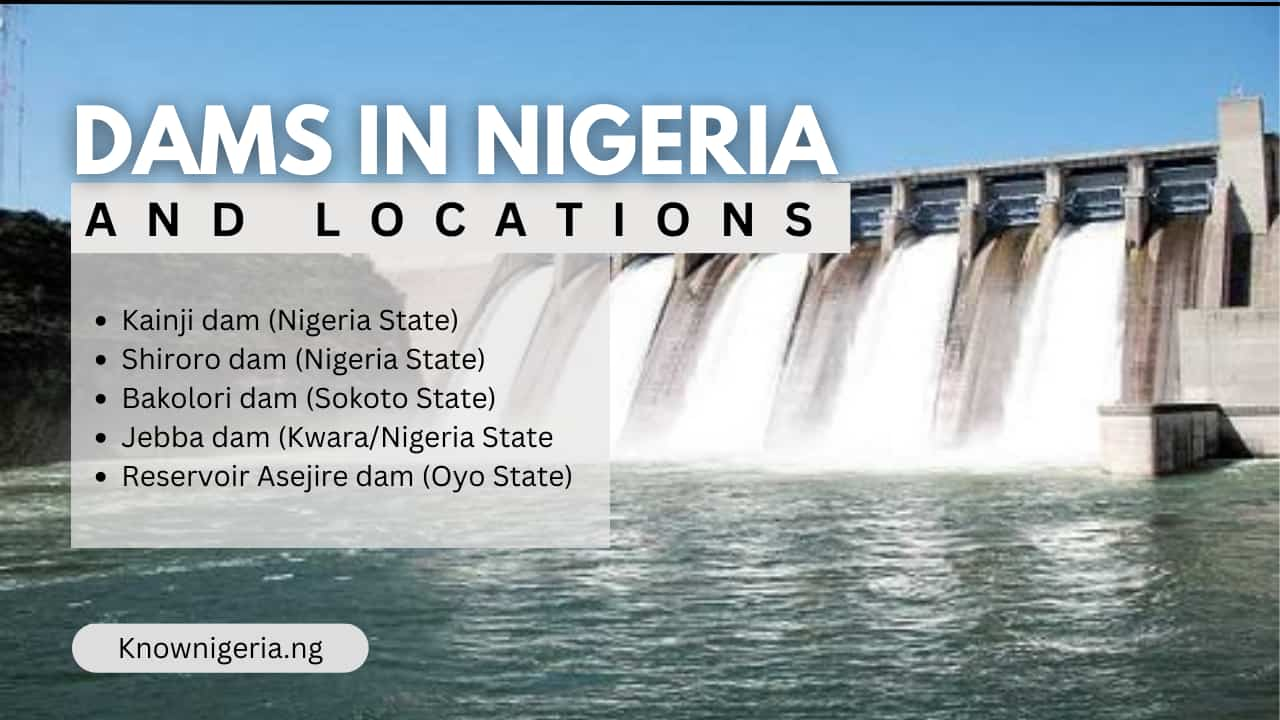Nigeria, a country in West Africa, is home to many dams essential to the nation’s growth and economics. These dams are used for various things, such as water supply, irrigation, flood control, and hydroelectric power production.
For several reasons, it is crucial to comprehend the importance of dams in Nigeria and their locations. This article will give a general review of Nigeria’s dams, emphasize their relevance, and review the importance of knowing where they are.
Table of Contents
What are Dams?
Dams are man-made structures that are designed to hold and control water. They can be constructed using various materials, such as concrete, rock, or earth-fill.
Dams serve various purposes, including flood control, hydroelectric power generation, irrigation for agriculture, navigation, and recreation.
The essential components of a dam include the foundation or base on which it is built, the wall or barrier that holds back the water, gates or spillways to release excess water during heavy rainfall or other emergencies, and a reservoir behind the dam where water is stored. The size and shape of dams vary depending on their purpose and location.
While dams offer many benefits, like providing renewable energy sources and preventing floods in low-lying areas, they can also negatively impact ecosystems by disrupting the natural habitats of aquatic species.
Read Also: 10 List Of Health NGOs Making An Impact In Nigeria
Dams’ Importance in Nigeria
In Nigeria, dams are essential to the nation’s growth. Dams are crucial for the following reasons:
Hydroelectric Power Generation
A significant source of electricity is produced by the hydroelectric power plants installed in several of Nigeria’s dams. This encourages industrial development, increases access to electricity in urban and rural regions, and aids in meeting the nation’s energy needs.
Agriculture and irrigation
By supplying water for irrigation, dams aid in developing agriculture. This makes it possible for farmers to cultivate their lands more effectively, resulting in higher crop yields, better food security, and expansion of the agricultural economy.
Flood control
By regulating river water flows, dams reduce the likelihood of flooding during heavy precipitation. They serve as a buffer, holding onto extra water and slowly releasing it, protecting downstream communities and lessening the effects of floods.
Dams act as reservoirs, holding domestic, commercial, and industrial water. They guarantee a consistent water supply for drinking, sanitation, and other uses, particularly in places lacking water.

Which are the Major Dams in Nigeria
Here are the Major Dams in Nigeria:
1. Kainji dam
Location: Niger State
First on our list of Dams in Nigeria is the Kainji Dam. Kainji Dam is a hydroelectric dam located in Nigeria’s Niger State. It was constructed in 1992 by the Nigerian government as part of its efforts to provide electricity to the state’s rural areas. The dam has a generating capacity of 760 MW, making it one of the largest hydroelectric dams in Africa.
The construction of the Kainji Dam involved the displacement and resettlement of thousands of people living within its vicinity. Despite this, the project has been instrumental in improving access to electricity for many people in Niger State.
The reservoir created by the dam also serves as a water source for irrigation and domestic use, further contributing to local economic development.
However, concerns have been raised over environmental degradation and inadequate compensation for those displaced during construction.
Read aLSO: 15 Best Private Universities In Nigeria
2. The Jebba Dam
Location: Niger State
On the Niger River in Nigeria, there is a hydroelectric power plant called the Jebba Dam. This is one of the popular Dams in Nigeria. Since the dam’s completion in 1985, the nation has relied heavily on it as a source of electricity. It is one of Nigeria’s most extensive hydropower facilities, with a total installed capacity of 540 MW.
The Niger River Basin Authority (NRBA), a regional agency managing water resources in nine West African nations, runs the Jebba Dam.
The dam helps increase access to energy in Nigeria by supplying electricity to urban and rural areas. The Jebba Dam generates electricity and acts as a flood control system, protecting the Niger River from harm caused by yearly flooding.
The Jebba Dam’s potentially harmful effects on the environment have been raised, despite its significance to Nigeria’s energy industry.
3. The Shiroro Dam
Location: Niger State
Next on our list of dams in Nigeria is Shiror Dam. The Shiroro Dam is one of Nigeria’s most significant hydroelectric power plants.
It was built across the Kaduna River in Niger State and commissioned in 1990 by former President Ibrahim Babangida. The dam generates electricity for many Nigerian households, industries, and businesses.
The construction of the Shiroro Dam created a large artificial lake that has become a popular tourist attraction and fishing spot. The lake also provides water for irrigation purposes for farmers living in the surrounding areas, leading to increased food production.
Additionally, it is a source of income for local fishermen who rely on it for their livelihoods.
Despite its numerous benefits, the Shiroro Dam faces challenges such as sedimentation build-up due to soil erosion from surrounding hillsides and climate change-induced droughts resulting in reduced water levels.
There have been calls for sustainable management practices to address these challenges to ensure its continued usefulness and longevity.
4. Reservoir Asejire
Location: Oyo State
When listing Nigerian Dams, Reservoir Asejire is among the popular ones. The Reservoir Asejire dams in Nigeria are an integral part of the country’s water management system.
The Asejire dam was built in the 1970s, and it is located on the Osun River, about 48 kilometers from Ibadan, the capital city of Oyo State. It has a 38 million cubic meters capacity and supplies water to over two million people in Ibadan.
The construction of the Asejire dam was part of a larger plan to increase agricultural production and provide clean drinking water to urban areas.
In addition to serving as a source of potable water, it also generates hydroelectric power that contributes significantly to Nigeria’s energy mix. The reservoir created by the Asejire Dam has become a popular tourist attraction and fishing location for locals and visitors alike.
Read Also: 12 Best Fast Internet Service Providers in Nigeria
5. Bakolori Dam
Location: Sokoto State
On the Rima River in the Sokoto state of Nigeria, the Bakolori Dam is a crucial water supply. To enhance irrigation agriculture and supply the area with hydroelectric power, this dam was built in 1978. The dam is 25.6 meters tall, 4,500 meters long, and has a 105 MW installed capacity.
The Bakolori Irrigation Scheme provides substantial advantages for crop cultivation and encompasses roughly 5,100 hectares.
The plan was created by leveraging well-integrated infrastructure for efficient crop management techniques to increase agricultural productivity through irrigation farming. This has enhanced local food production, benefiting nearby towns’ economic health.
Despite its many advantages, Bakolori Dam has several drawbacks, such as siltation, which may diminish its storage capacity over time.
6. Challawa Gorge Dam
Location: Kano State
Another well-known dam in Nigeria is Challawa Gorge Dam. This Dam is a significant source of hydroelectric power and irrigation water supply in the northern Nigerian state of Kano.
The dam was constructed in the early 1980s to use the River Challawa’s water for industrial and agricultural reasons. The Hadejia-Jama’are-Komadugu-Yobe Basin Development Authority comprises many dams, including this one.
The Challawa Gorge Dam is an earth-fill structure with a length of nearly 7 kilometers and a height of over 43 meters.
The dam’s reservoir, which it built, has a volume of around 50 million cubic meters and a surface area of more than 12 square kilometers. This hydroelectric project produces electricity that powers Kano, a metropolis with a population of more than six million population.
7. Dadin Kowa Dam
Location: Gombe State
The Gongola River in Gombe State, Nigeria, is home to the multipurpose Dadin Kowa Dam. The dam produces hydroelectric electricity for domestic and commercial usage and irrigation water for agricultural purposes.
Since its completion in 1983, this project has substantially contributed to the growth of Gombe State’s economy.
When filled with water, the Dadin Kowa Dam has a 200 million cubic meters capacity and a surface area of 56 square kilometers.
More than 30,000 hectares of farmland receive water from it, allowing farmers to grow crops all year round. Additionally, various settlements in Gombe and the adjacent states receive electricity from the hydroelectric power produced by the dam.
It took five years to finish the tremendous task of building the Dadin Kowa Dam. Domestic and foreign sources of investment money totaling more than $100 million were needed.
8. Goronyo Dam
The Goronyo Dam is a crucial source of irrigation and hydroelectric power in Nigeria. The Nigerian government built the dam in 1981 to capture water from River Rima for irrigation in Sokoto State, North-Western Nigeria. Since being rebuilt to produce energy, the dam significantly contributes to Nigeria’s power grid.
Over 3 kilometers of the River Rima are covered by the 33-meter-high Goronyo Dam. Its reservoir is around 78 square kilometers and has a 2 billion cubic meters capacity.
The Sokoto Rima River Basin Development Authority (SRRBDA), which manages the dam, is also responsible for its upkeep and management.
In addition to producing energy, Goronyo Dam also supplies water for nearby farms to use for irrigation.
Read Also: 14 Best Textile Companies in Nigeria
9. Gusura Dam
Location: Zamfara State
One of Nigeria’s most significant dams, the Gusura Dam, is situated in the Gusau area of Zamfara State. The dam was constructed to meet the state’s water needs to enhance irrigation, electrical production, and flood control. It has a capacity of around 200 million cubic meters and a surface area of 24 square kilometers.
To improve Nigeria’s agricultural and electricity supply, the federal government launched the construction of the Gusura Dam in collaboration with foreign companies.
The project started in 2013 and cost N19 billion (approximately $50 million). After being finished, it produced more than 1.2 megawatts of hydroelectric power to help industry and rural electrification in the area.
By providing sufficient water for farming operations and mitigating the effects of climate change, such as droughts and floods, Gusura Dam is now playing a critical role in boosting food security.
10. Ikere Gorge Dam
Location: Oyo State
A multipurpose hydroelectric power project called Ikere Gorge Dam is in Nigeria’s Oyo state. The dam’s main objectives during construction in the late 1960s and early 1970s were to produce power and provide water for irrigation. It is one of Nigeria’s giant dams, with a maximum storage capacity of 690 million cubic meters.
Oyo state’s and Nigeria’s overall economic development have significantly benefited from the Ikere Gorge Dam. The power produced by the dam has accelerated industrialization, expanded access to electricity, and given thousands of people job possibilities.
Additionally, because of the enhanced water supply provided by irrigated farming made possible by this dam, farmers have grown crops year-round.
Even though running Ikere Gorge Dam has many advantages, there are specific difficulties.
11. The Jibiya Dam
Location: Katsina State
Nigeria’s Jibiya Dam is an essential piece of infrastructure that is essential to the economic and social development of the nation.
The Jibia River dam in Katsina State was constructed to provide water for irrigation, mainly for farming activities.
The dam’s construction was finished in 1984, and ever since, it has been used for various things, including flood control, hydroelectric power generation, and water delivery.
The Jibiya Dam spans around 2000 hectares and has a 34 million cubic meter capacity. Its main objective is to supply irrigation water for more than 20,000 hectares of farmland near Katsina state.
It also acts as a source of electricity generation that supports the regional industry in these areas due to its advantageous location close to important urban centers like Sokoto and Kano States.
12. Kafin Zaki Dam
Location: Bauchi State
Nigeria is home to the multifunctional hydropower Kafin Zaki Dam. In the state of Bauchi, a dam was built over the Kafin Zaki River, and ever since, the area has relied heavily on it as a water supply for irrigation. The dam’s construction started in 1975 and was finished in 1980.
The dam, which has a height of around 32 meters and a length of more than 3 kilometers, produces a sizable reservoir with a surface area of more than 65 square kilometers.
Water from the reservoir is used for agricultural purposes in the local settlements, and its hydropower turbines also produce energy.
Up to 40 megawatts of energy are now produced by the Kafin Zaki Dam and delivered to various regions of Nigeria.
13. Kiri Dam
Location: Adamawa
A significant water storage facility is the Kiri Dam, which is situated in Nigeria’s Adamawa State. It was constructed in 1982 to function as a hydroelectric power plant and irrigate farmlands nearby. The dam was given the name Kiri in honor of a nearby village.
One of the largest dams in Nigeria, the Kiri Dam, has an estimated 45 million cubic meters of water storage capacity and is almost 16 kilometers long.
In addition to supplying irrigation water for crops like rice, maize, and sorghum, its primary duties include supplying electricity to the National Grid and supporting agricultural endeavors.
It is impossible to overestimate the effects of Kiri Dam on the neighborhood. Since its creation, it has given thousands of nearby families access to clean drinking water.
Read Also: 10 Best Old Peoples Homes in Lagos Nigeria
14. Mambilla Dam
Location: Taraba State
A hydroelectric power project called the Mambilla Dam has been in the works for many years in Nigeria. With irrigation water for more than 100,000 hectares of farmland, it can produce up to 3,050 megawatts of energy. The dam, built on the Dongo River in Taraba State, will result in a 50 billion cubic meter reservoir.
The Mambilla Dam’s construction has had repeated delays due to financial problems and local political unrest. But in May 2021, President Muhammadu Buhari accepted a $5.792 billion deal for a consortium led by China Gezhouba Group Corporation (CGGC) to build the dam.
The project will generate thousands of employees during its development phase and is anticipated to take six years to finish.
15. Obudu Dam
Location: Cross River State
Cross River State is where the Obudu Dam is situated. It has a capacity of 4.2 million m3, a height of 15 m, and a total crest length of 425 m. The dam was put into service in 1999 for irrigation of farms, tourism, fishing, and other leisure activities.
16. Polder Zauro Project
Location: Kebbi State
The Zauro Polder Project in Kebbi State is a significant irrigation and water management plan. Improve irrigation techniques and agricultural productivity in the area. It entails building a dam, canals, and drainage channels. The project intends to increase agricultural development, particularly in rice farming, and to supply water resources for irrigation.
17. The Zobe Dam
Location: Katsina State
The Zobe Dam is a multipurpose dam with several uses in Katsina State. It supplies water for irrigation, assisting in agricultural endeavors and raising crop yields. The dam also aids in flood control efforts and adds to household water supply, safeguarding the safety of neighboring towns.
Read Also: 16 Best Inverter Brands in Nigeria
Conclusion
Nigeria’s impressive collection of dams plays a crucial role in the nation’s infrastructure and economy. These structures provide irrigation for agriculture, hydroelectric power for industries and households, and water supply for communities.
The government must continue to prioritize the maintenance and expansion of these dams to ensure their longevity and effectiveness.
Furthermore, stakeholders should increase awareness about dam construction and management’s environmental impact and promote sustainable practices in this sector. With concerted efforts from all parties involved, Nigeria’s dams can continue to serve as valuable assets for future generations.
If you like our content, we know you would love our awesome content on our Youtube channel, Tiktok, Facebook, Instagram, and Twitter. Please subscribe and follow us for more Premium Know Nigeria content.
References
RECOMMENDATIONS
- Beautiful Yoruba Tribal Marks and Their Unique Meanings
- 10 Best Old Peoples Home in Lagos Nigeria
- 30 Unique Tribal Braids You Can Find in Nigeria
- Best Places To Learn Coding In Lagos










